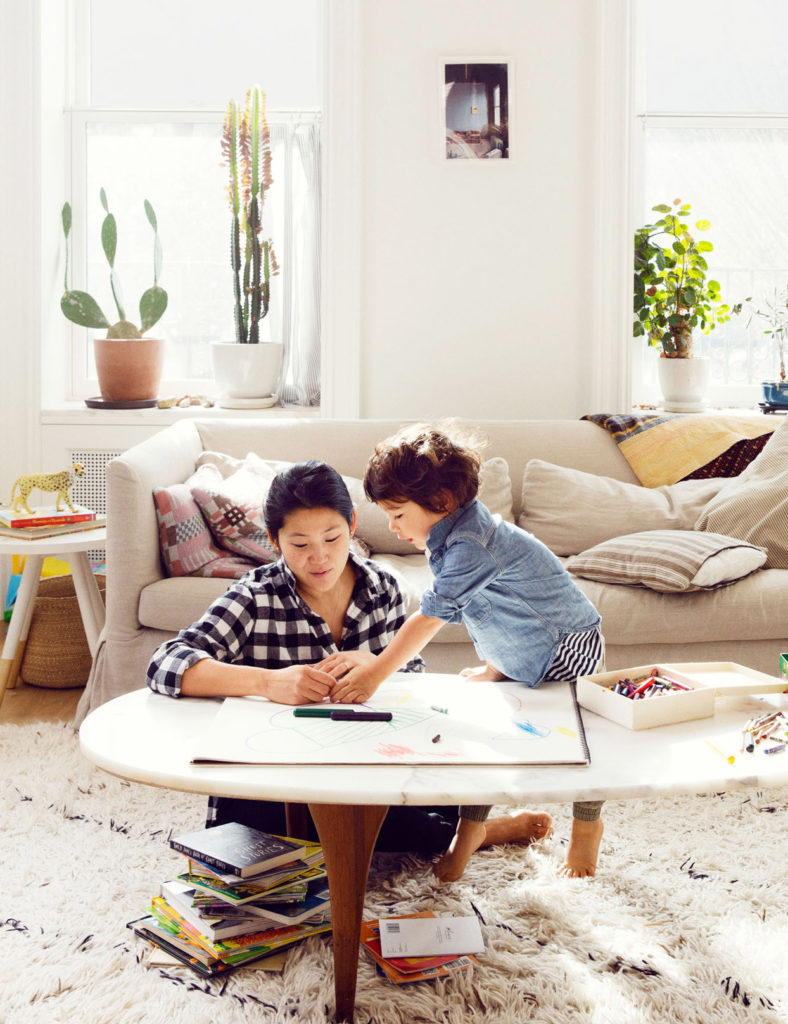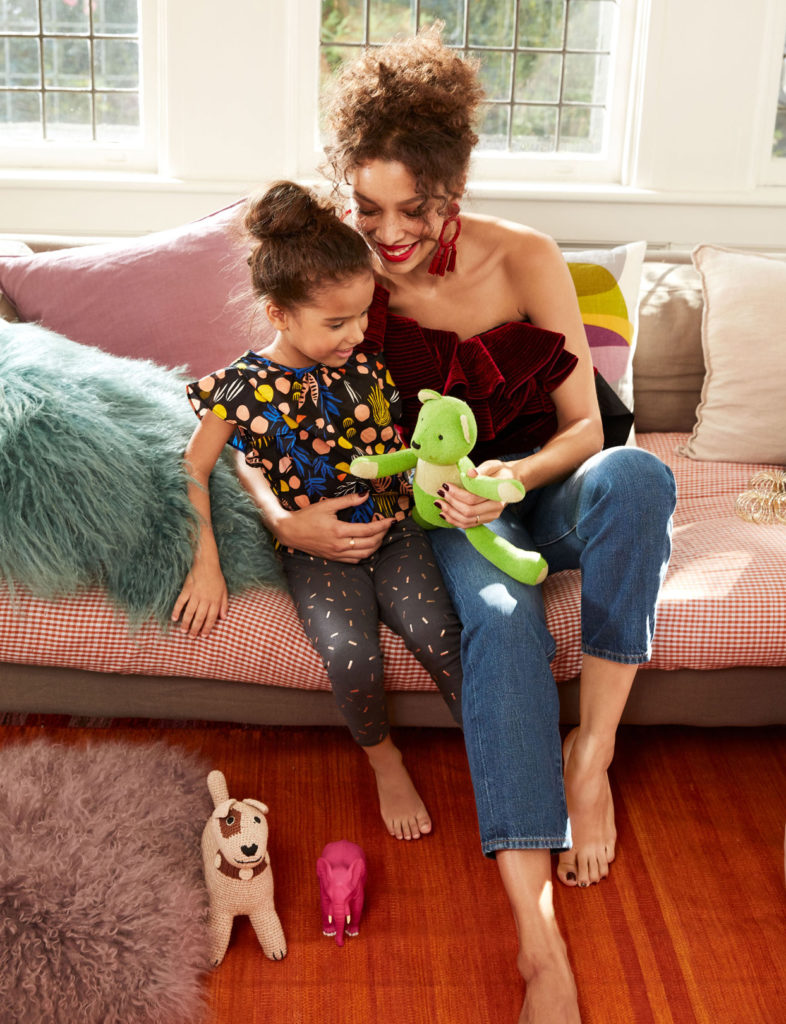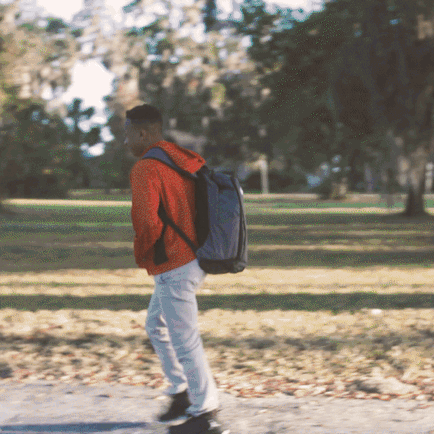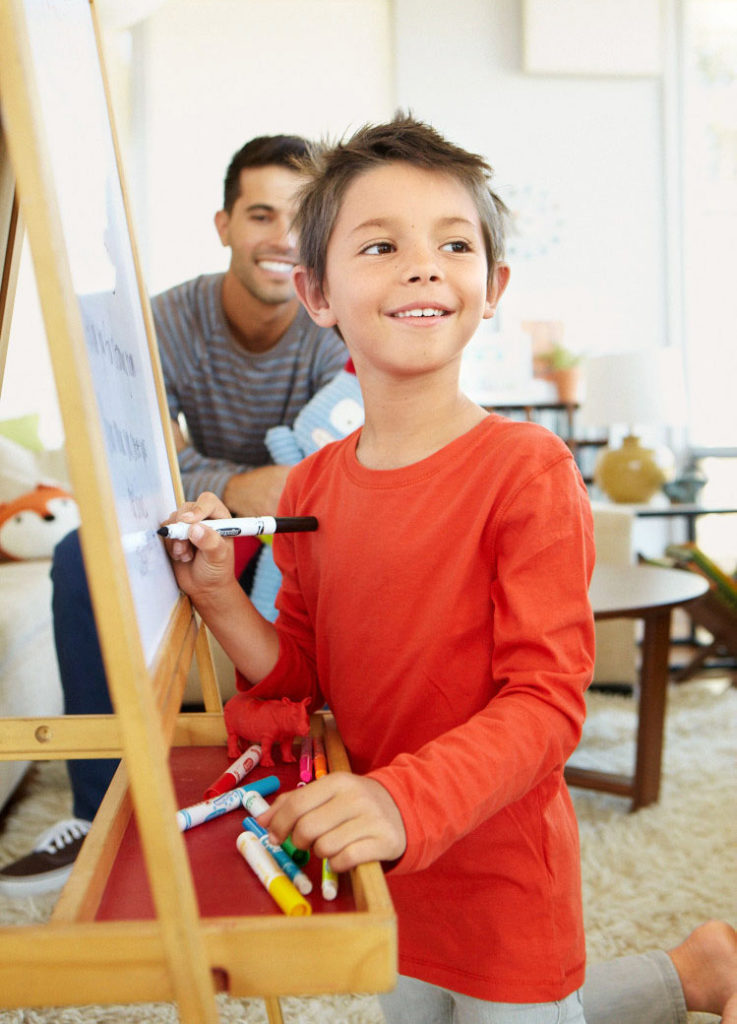Whether your child struggles with outbursts, focus, or fidgeting, educators say these research-backed classroom techniques can make a real difference, right in your own home.
For what seemed like ages, my then 3-year-old daughter, Edie, freaked out whenever we tried to wash her hair. She screamed. She cried. Her pixie-like frame shook with panic. “Oh, you know, it’s just bathtime,” I imagined myself explaining to the neighbors, who could surely hear the nightly screechfest.
I tried everything to get her hair clean without the hysterics, from letting her pick out Teenage Mutant Ninja Turtles shampoo to folding my 5-foot-10 self into the tub with her. But it was my husband, a special-education teacher, who was finally able to help our typically developing daughter get over her phobia.
He sat down next to the bathtub one night and asked Edie why she was afraid. He listened and then asked what would help her feel better. Together, the two of them came up with a plan: They’d watch an episode of Daniel Tiger’s Neighborhood about getting clean, and then try it out themselves. I peeked into the bathroom. “I’m CPS-ing,” Eric whispered to me.
That acronym wasn’t an attempt to hide something from our kids (“Where’d we put the d-o-n-u-t-s?”). Rather, Collaborative Problem Solving (CPS) is an approach he uses to help students in his class work through their own obstacles.
Special education, broadly defined, means providing the tools, environment, support, and instruction that kids with diagnosed disabilities need in order to learn. However, CPS isn’t the only special-ed approach that benefits children of all abilities. “Applying some basic principles of learning can create a happier and more productive environment for everybody in the family,” says William Heward, Ed.D., professor emeritus at the College of Education and Human Ecology of Ohio State University and author of Exceptional Children: An Introduction to Special Education.
If you’re regularly challenged by your kid’s garden-variety issues like having meltdowns, getting impatient, or kicking the back of your seat, consider nine beyond-the-classroom skills.
Cue What’s on Deck
Special-education teachers rely heavily on routines and visual cues of what’s coming up next so that students won’t be surprised and then act out. You can adapt this tactic outside the classroom, says Roberta Dunn, executive director of the disabilities advocacy group FACT Oregon. For example, if your kid constantly asks, “Are we there yet?” even if you’re just driving across town, Dunn suggests breaking up the trip the same way teachers break up the day. You might say, “First we’ll pass the used-car lot with the balloons,” and your kid will peer out the window. Once you pass the dealership, tell them the next landmark, and so on until you arrive. Boom—you’ve turned a chore into a super-fun scavenger hunt. “Breaking down a day, a schedule, or even a car ride into units establishes targets where children can direct their energy,” Dunn says.

Use DIY Tricks to Fight Fidgeting
Educational supports are all the rage (remember fidget spinners?), in part because research shows they help some students sharpen their focus and improve memory. But impulse-buy gadgets aren’t the only supports that work. You can raid your closet or even your utensil drawer to MacGyver a support—aka anything that helps your child’s attention or burns up energy, Dunn says. For example, if your child constantly stands up on their chair during meals, they’re probably holding in extra oomph that needs to go somewhere. You can wrap a bungee cord or a physical-therapy band between the legs of their chair that they can kick all they want.
Avoid Using the Word But
How many times have you had this argument, or one like it: Your child is building with LEGO bricks and it’s time for bed. You point out that the timer went off and they need to leave their project until tomorrow. They protest. You say you understand, but it’s bedtime, end of story. You might feel like you’re being empathetic—after all, you listened to and repeated back their objections—but saying but actually undermines the common ground you’re trying to build.
“The word but belittles your child’s voice because it signals their opinion isn’t as important as yours,” says Meagan McCarthy, a special-education teacher in Tucson. Instead, try a CPS technique called the Plan B Conversation, which McCarthy uses in her classroom. When you and your child want different things, paraphrase their concern. Say, “I hear that finishing your LEGO castle is really important to you.” Then state what’s important to you. Try, “My concern is that you get enough rest so you’re ready to learn at school.” Then ask them to suggest a Plan B—like finishing one tower now and the rest tomorrow before breakfast.
McCarthy says, “The idea is to work together to find a solution that meets both of your needs, not to enforce Plan A, which is all about the adult’s will.” If you and your child come to an impasse—say, they refuse to turn off the TV to get ready for bed—try to find out why they feel so strongly. (Maybe it’s their favorite show or they didn’t get any other screen time that day.) Try to use that intel to come up with a compromise (make sure they get to watch tomorrow). If you truly can’t make a deal, let the issue go (they can experience the natural consequence of being tired the next day), and come back to it when you are in a better headspace. A key exception: Matters of safety are always nonnegotiable.
Tune in to Emotions
Some special-education classrooms are called life-skills programs because they help children with disabilities learn fundamental skills—like listening instead of interrupting, tying their shoes, or washing their hands after using the bathroom—in order to thrive in the wider world. Emotional literacy is a huge component of these lessons.
“Helping kids be aware of what they’re feeling offers them an opportunity to own what is going on in their body,” Dunn says. You can make abstract concepts—such as embarrassment, anxiety, or excitement—more concrete by doing a simple exercise that Dunn recommends. Ask your child to check in with their body by placing a hand over their heart. Is it beating fast or slow? What’s their breathing like? Is there tension in their shoulders or belly? Then you can help them match the name for a feeling with how their body is reacting. That’s the first step in learning to manage their emotions, Dunn says.
Find a Safe Outlet for Big Feelings
Sometimes, in spite of their best efforts, your kid will spiral into a tantrum. Those out-of-control feelings can be scary for children, so it’s up to you to teach them to de-escalate, McCarthy says. One of her favorite tools to use when this happens is the push/pull technique. Face your child, clasp both of their hands in yours, and let them push into your palms while they breathe out. Then have them pull on your hands, leaning back, as they breathe in. They can also do this on their own: Encourage them to push as hard as they can on a closed door, then hold on to the doorknob and pull back with the door closed. “This gets their aggression out in a safe way, and they can do it anywhere,” McCarthy says.
Give Purposeful Praise
We’ve all heard about the moratorium on telling your child “Good job”: The antipraise camp asserts that too much positive feedback can make kids less independent and even turn them into “praise junkies.” However, strategically recognizing the behavior you want your children to repeat—like sharing with a sibling or putting away their toys—is precisely what encourages them to keep at it, says Dr. Heward. Positive Behavior Interventions and Supports is a special-education system that recommends using a ratio of five compliments to one criticism (or exasperated shout of “For the last time, stop teasing the dog!”). This ratio can reinforce things like taking turns, walking safely in a parking lot, or setting the table without being asked. Studies show that when teachers and parents ratchet up their praise, children stay on task more, act out less, and even make faster progress learning to read.
Instead of fretting about going overboard with praise, Dr. Heward suggests focusing on varying the type of praise you give, mixing in a verbal thumbs-up (“Thank you for finishing your homework before using your tablet”) with other positive attention (“When you’re done with your book report, will you tell me about it?”). To remind yourself to praise more often, Dr. Heward offers this technique: Put 10 pennies in one pocket at the beginning of the day. Each time you catch your kid being good, say so (“I love that you and your sister are playing so well together!”) and move a penny to another pocket. The physical reminder prompts you to look for everything they’re doing right. If you move all ten pennies, reward yourself with something nice.
Write the Right Kind of Cooperation Contract
Have you ever created a strategy—say, a sticker system to encourage your kid to clean their room—that flopped? Chances are it failed because your kid’s idea of completing a task (bed made, toys stored) doesn’t match your own, Dr. Heward says.
The remedy: a behavioral contract between you and your child. It’s derived from Applied Behavior Analysis (ABA), what Dr. Heward calls “the science of behavior change” that is behind the most effective education programs for children with autism and other disabilities. Behavioral contracts specify each step or component of a desired task or activity, as well as the reward for accomplishing that step. The contract must be fair—the reward neither too big nor too small—and signed by both of you. (For prereaders, you can draw or use clip art to visually represent the task and the reward.) You’ll want to make sure that the reward is immediate (say, a sticker), the prize is motivating (like a mini Hatchimal or a bottle of bubbles), and your expectations are age-appropriate. “Contracting is a research-based strategy to help kids and parents succeed,” Dr. Heward says.
In my household, for example, we laminated morning and evening routine checklists, then signed them as contracts. Even my 5-year-old, Maxine, recognizes the pictures that I drew illustrating everything she needs to do before bed (wash her face, put dirty clothes in the hamper), and she knows she gets a sticker when she completes her jobs without being nagged. And since both my girls know they get a prize from the goodie bag after they earn five stickers, we don’t have to constantly negotiate about when they’ll get a new tiny toy.
Create a Secret Code
Kids of all abilities don’t always have the words to ask for help when they’re getting “emotionally dysregulated” (psychologist-speak for having an outsize response to daily problems). Dunn recommends coming up with a signal your kid can use when they’re starting to get amped up, like rubbing their hands together.
That’s your cue that your kid needs help calming down. Test out strategies (cuddling, taking a walk, belly breathing) until you find one that works. A friend of mine who’s a social worker sings the alphabet song to her 6-year-old. Without fail, that familiar tune soothes her first-grader and prevents epic meltdowns. Eventually, your child may learn to do the same thing to soothe themself.
Anticipate Triggers
My husband could predict with stunning accuracy what would set off each child in his classroom, and chances are you know what triggers your child as well. So identify—and then plan for—situations that may spark an outburst.
For example, Edie panics if she’s in a loud environment for long. So before a family wedding a few years back, we created a detailed blueprint for what she could do (draw in her coloring book) and where (on the sofa next to the women’s bathroom) whenever she needed a break from the party. “Empower your child to own what they need to do,” says Dunn. “That alleviates the anxiety of going into a situation they know can be triggering.”
In fact, Dunn recommends that parents do the same, like finding a quiet corner of your house the next time lockdown fatigue sets in. Turns out we grown-ups can learn a few lessons too.
Source: Parents




